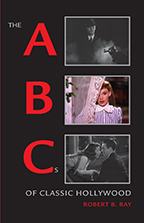About This Exhibit
Eenie Meenie Miney Mose is an online and physical exhibit (located at the John C. Hitt library at the University of Central Florida) exploring race and hidden details in Richard Outcault’s Pore Lil Mose comic strip (1900-1902). It is curated by Amanda Hill, Mark Kretzschmar, David Morton, and Sara Raffel, all PhD students in the Texts and Technology degree program at UCF. The method of curation is inspired by Robert Ray’s 2008 book, The ABCs of Classic Hollywood in which he finds hidden details in classic films as a way of considering unexplored meanings within the films.

The curators of this exhibit have pinpointed a few details on five comics found in the Carol Mundy Collection to invoke conversation. We encourage you to join the conversation by suggesting additional details and meanings in the comments.
Who is Robert Ray?
In The ABCs of Classic Hollywood, Robert Ray conducts a close examination of four classic Hollywood films: The Grand Hotel, Meet Me in St. Louis, The Philadelphia Story, and The Maltese Falcon. In his introduction, he begins with a quote from film director Vincente Minnelli:
“I feel that a picture that stays with you is made up of a hundred or more hidden things. They’re things that the audience is not conscious of, but that accumulate” (xi).

Ray combines additional inspiration from theorists and the likes of Sherlock Holmes and Andre Bazin with the help of his students to explore these four films, looking for details he can use to create new areas of meaning. He structures his findings in the form of an encyclopedia and arranges his findings alphabetically for each film. The words Ray uses to represent a letter are details of the larger film texts. These details are specific to different moments throughout the film and differ from most film criticism that focuses on larger concepts and themes throughout the texts. These details guide his criticism in fortuitous and often unpredictable ways.
Using Ray’s work as a frame, this exhibit takes sometimes-minute details of the Pore Lil Mose comic strips into consideration, inviting engagement with hundred-year-old texts in new ways. Ray relies on unpredictability in order to find new meaning within a text. The found details are contingent upon language systems and politics for their meaning. In this way, each reader has the ability to see details within the Pore Lil Mose comics and create fresh insight into the larger texts.
By positioning the discovered details on flash cards that represent the way children learn the alphabet, we invite you into a space where you can join us in new knowledge discovery.
Special thanks to Dr. Barry Mauer and Clayton Benjamin for creative and technological support.
Works Cited in this Exhibit
- Daniels, Jim. M-80. Pittsburgh, PA: University of Pittsburgh Press, 1993. Print.
- Goldenberg, David M. The Curse of Ham: Race and Slavery in Early Judaism, Christianity, and Islam. Princeton, NJ: Princeton University Press, 2005. Print.
- Gordon, Ian. “Comic Art and the Commodification of African American Typographies.” Comic Strips & Consumer Culture: 1890-1945. United States: Smithsonian Institution, 1998. 59-71. Print.
- Harvey, Paul. Redeeming the South: Religious Cultures and Racial Identities Among Southern Baptists, 1865-1925. Chapel Hill, NC: University of North Carolina Press, 1997. Print.
- Havig, Alan. “Richard F. Outcault’s ‘Poor Lil’ Mose: Variations on the Black Stereotype in American Comic Art.” Journal of American Culture 11.1 (1988): 33-41. Print.
- Ray, Robert. The ABCs of Classic Hollywood. New York: Oxford University Press, 2008. Print.
